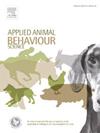尾母羊和断尾母羊的性吸引力和接受性
IF 2
2区 农林科学
Q1 AGRICULTURE, DAIRY & ANIMAL SCIENCE
引用次数: 0
摘要
切除一部分尾巴,也被称为断尾,通常在羊身上进行。然而,有证据表明,小型反刍动物物种的雌性在性环境中使用它们的尾巴进行交流。本研究的目的是测试母羊的尾巴状态是否影响母羊和公羊的交配行为。在18对Polypay雌性双胞胎中,通过在24至36岁 h的尾巴上放置一个狭窄的橡胶圈,一只羊羔被扣住,而她的妹妹的尾巴则不被扣住( = 18只羊羔/治疗)。当母羊长到7-8月龄时,母羊的发情周期同步,9组4只母羊(2对双胞胎/组)每组暴露于一只不熟悉的处女公羊(n = 9;7-8个月大)为48 h。在头2个 小时内记录下行为互动的视频,并进行分析,以确定公羊调查每只母羊会阴区域并骑上母羊的延迟时间、会阴调查的持续时间、对母羊的头撞和骑上尝试的次数,以及母羊接受骑上的比例。我们使用实时位置传感器记录每秒钟母羊和公羊的x、y位置,从中我们确定每只母羊的总距离和到公羊的平均距离。未停靠的母羊往往更早被公羊骑上,当被骑上时,与停靠的母羊相比,往往接受更多的骑乘。没有观察到停靠和未停靠母羊在任何其他行为上的差异。这些发现表明,断尾的新生母羊可能会在以后的生活中降低性吸引力和接受性,对生殖成功有潜在的影响。本文章由计算机程序翻译,如有差异,请以英文原文为准。
Sexual attractivity and receptivity in tailed and docked ewes
Removing a portion of the tail, also known as tail docking, is commonly performed in sheep. However, there is evidence that females of small ruminant species use their tails to communicate in sexual contexts. The objective of this study was to test whether a ewe’s tail status affected the mating behavior of ewes and rams. Within 18 Polypay female twin pairs, one lamb was docked between 24 and 36 h of age by placing a constrictive rubber ring on the tail while her sister’s tail was left undocked (n = 18 lambs/treatment). The estrous cycles of the ewes were synchronized when they reached 7–8 months of age, and 9 groups of 4 ewes (2 twin pairs/group) were each exposed to a single unfamiliar virgin ram (n = 9; 7–8 months of age) for 48 h. Behavioral interactions were video recorded over the first 2 h and analyzed to determine the ram’s latency to investigate each ewe’s perineal region and to mount her, the duration of perineal investigation, the number of headbutts and mounting attempts towards the ewe, and the proportion of mounts that the ewe accepted out of the total attempted mounts. We used real-time location sensors to record the x, y location of ewes and rams every second, from which we determined each ewe’s total distance traveled and average distance to the ram. Undocked ewes tended to be mounted sooner by the ram and, when mounted, tended to accept more mounts compared to docked ewes. No differences were observed between docked and undocked ewes in any of the other behaviors. These findings suggest that tail docking neonatal ewe lambs may reduce sexual attractivity and receptivity later in life, with potential implications for reproductive success.
求助全文
通过发布文献求助,成功后即可免费获取论文全文。
去求助
来源期刊

Applied Animal Behaviour Science
农林科学-行为科学
CiteScore
4.40
自引率
21.70%
发文量
191
审稿时长
18.1 weeks
期刊介绍:
This journal publishes relevant information on the behaviour of domesticated and utilized animals.
Topics covered include:
-Behaviour of farm, zoo and laboratory animals in relation to animal management and welfare
-Behaviour of companion animals in relation to behavioural problems, for example, in relation to the training of dogs for different purposes, in relation to behavioural problems
-Studies of the behaviour of wild animals when these studies are relevant from an applied perspective, for example in relation to wildlife management, pest management or nature conservation
-Methodological studies within relevant fields
The principal subjects are farm, companion and laboratory animals, including, of course, poultry. The journal also deals with the following animal subjects:
-Those involved in any farming system, e.g. deer, rabbits and fur-bearing animals
-Those in ANY form of confinement, e.g. zoos, safari parks and other forms of display
-Feral animals, and any animal species which impinge on farming operations, e.g. as causes of loss or damage
-Species used for hunting, recreation etc. may also be considered as acceptable subjects in some instances
-Laboratory animals, if the material relates to their behavioural requirements
 求助内容:
求助内容: 应助结果提醒方式:
应助结果提醒方式:


